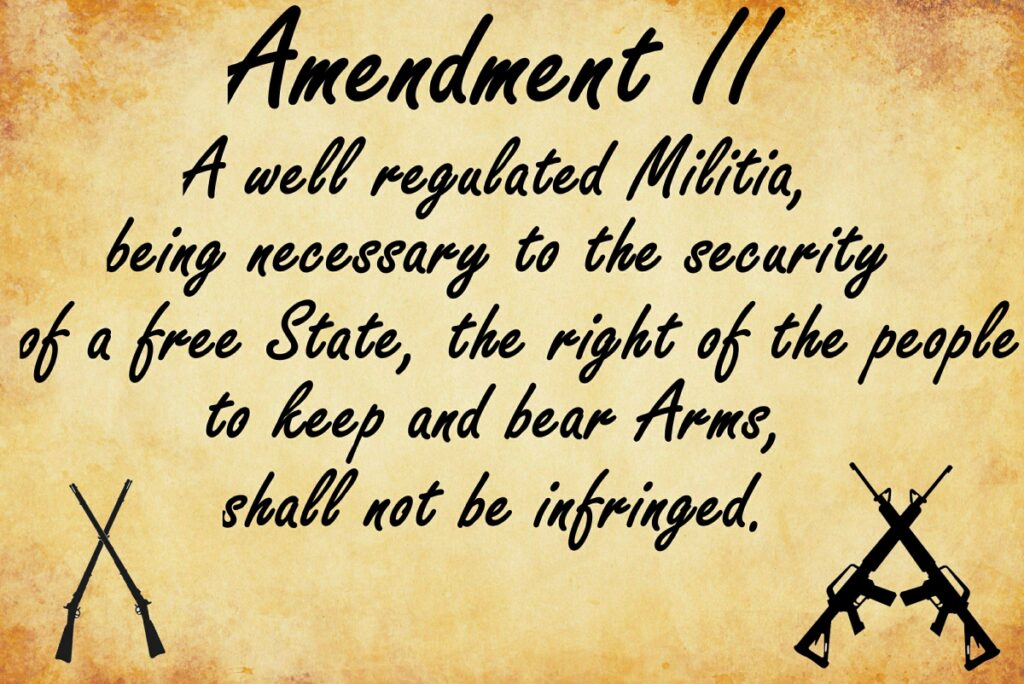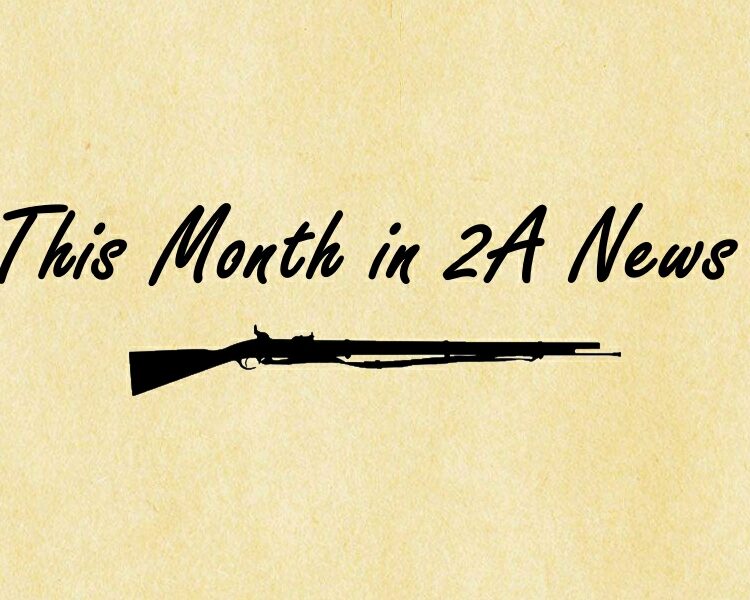April saw some big moves in the 2A world. The Supreme Court, ATF, and Commerce Department all made moves, while several states and lower courts also took significant action. We also have an eye-opening report on detachable magazines from the National Shooting Sports Foundation. Many of these are preliminaries for potentially big news this summer. Let’s begin with the ATF.

“Engaged in the Business”
The Bureau of Alcohol, Tobacco, Firearms, and Explosives (ATF) announced a new Final Rule that essentially outlaws private firearms sales. ATF calls the new rule the Definition of “Engaged in the Business” as a Dealer in Firearms. It will take effect on May 10, 2024. Basically, the rule requires anyone selling a firearm to a person other than a close family member to have a Federal Firearms License (FFL). You read that right.
The rule supposedly targets “rogue” firearms dealers and closes the mythical “gun show loophole,” despite ATF data showing that very few crime guns are bought at gun shows. Most are stolen. This rule is the anti-2A Biden Administration’s attempt to implement so-called “universal” background checks without Congressional approval. The administration stated that they would pursue such a program using the White House Office for Gun Violence Prevention, which was established for the express purpose of sidestepping Congress. This one resulted from a March 2023 Biden Executive Order.
The rule itself is vague, as ATF rules tend to be, especially under the current administration. It redefines who is “engaged in the business” of selling firearms. The rule claims it targets individuals who sell guns for profit, though the White House website makes it clear that just selling a single firearm may be sufficient to require a license. Even worse, the rule states that “Even a single firearm transaction, or offer to engage in a transaction, when combined with other evidence, may be sufficient to require a license.” The rule does not define “other evidence,” though statements from ATF officials indicate that even intending to make a profit, even on a gun whose value has increased, will suffice. Violations could result in a 5-year federal prison sentence and a $250,000 fine.
Lawsuits challenging the rule are already on the way. It’s difficult to see how this rule can stand. Its outrageousness matches the other Biden ATF rules that are currently losing in court. But it will likely take a couple of years to litigate the case. It’s important to be aware of this situation if you’re looking to sell a firearm. We’ll keep you updated.
Supreme Court to Hear ATF Frames & Receivers Case
Speaking of ATF rules, the United States Supreme Court has accepted the Justice Department’s appeal of VanDerStok v. Garland. That case is a challenge of the ATF’s Frames & Receivers rule, or the “Ghost Gun” rule, as the media calls it.
In case you hadn’t heard, the rule unilaterally changed the definition of “firearm,” despite Congress clearly doing so in the 1968 Gun Control Act (GCA). The GCA defines a “firearm” as follows:
- Any weapon (including a starter gun) which will or is designed to or may readily be converted to expel a projectile by the action of an explosive;
- The frame or receiver of any such weapon.
The GCA also defined “frame or receiver” as “that part of a firearm which provides housing for the hammer, bolt or breechblock, and firing mechanism, and which is usually threaded as its forward portion to receive the barrel.”

The ATF is an Executive agency and lacks the authority to change statutes passed by Congress. But the agency did so anyway, effectively merging parts (A) and (B) above by adding the phrase “may be readily converted” to the term “frame or receiver.”
The plaintiffs, Jennifer VanDerStok, the Second Amendment Foundation (SAF), and the Firearms Policy Coalition (FPC) challenged the rule and won in Federal District Court. The Justice Department, of which ATF is a part, appealed to the 5th Circuit Court of Appeals, where they lost again. They have now appealed to the Supreme Court, which has agreed to hear the case. Here’s hoping the Justice Department goes 0 for 3 in this case. We expect a ruling sometime this summer.
Mexico Lawsuit to the Supreme Court?
Staying with the high court, US gun manufacturers have asked the Justices to accept an appeal of the Mexican government’s $10 billion lawsuit, which claims American companies are responsible for that country’s lawless violence.
Mexico says that US firearms manufacturers produce semi-automatic weapons, especially guns like the AR-15, and magazines holding more than 10 rounds, some of which are smuggled into Mexico to the drug gangs. The complaint further alleges that these companies willfully take no steps, aside from those required by US law, to mitigate the damage caused by their products’ misuse in Mexico.
That’s the entire suit. Mexico cannot cite even one instance in which American gunmakers broke the law. They are suing these companies for lawfully making, marketing, and selling legal products. It doesn’t make any sense. The Brady organization, a leading American gun control group, instigated the suit. That’s why it makes no sense. It’s based on ideology, not legality, which is par for the course.
The suit seeks to impose Mexican-style gun control on the US by forcing gun companies to adopt policies not required by US law, and which are probably 2A violations. Those policies would include ceasing production of guns Mexico and Brady don’t like, and only selling guns to people who can demonstrate a special need. Such things are obviously unconstitutional.

The American companies are asking the Supreme Court to settle two questions:
- Whether the production and sale of firearms in the United States is the “proximate cause” of alleged injuries to the Mexican government stemming from violence committed by drug cartels in Mexico.
- Whether the production and sale of firearms in the United States amounts to “aiding and abetting” illegal firearms trafficking because firearms companies allegedly know that some of their products are unlawfully trafficked.
Incredibly, the 1st Circuit overturned a federal district judge’s dismissal, answering those questions in the affirmative. The court also found that Mexico’s alleged injuries were a “foreseeable” result of the defendants’’ actions. In other words, the 1st Circuit believes that US gun companies are somehow responsible for Mexican drug cartels’ violent actions. The 1st Circuit has never been 2A-friendly, but this is ridiculous.
This is a big deal. It could cripple the US firearms industry, which is the gun controllers’ new preferred tactic. We’ll revisit that momentarily. It would also set a terrible precedent of allowing foreign governments to dictate US law. Other nations are already lined up to sue American gun makers if the 1st Circuit’s decision stands. We hope the Supreme Court will accept this case and end the nonsense. If the US government isn’t allowed to violate the 2A, why in the world should other countries be allowed to do it?
Commerce Department Severely Restricts US Firearms Exports
Speaking of hurting US gun companies’ finances, the US Commerce Department has just announced a new rule that severely restricts firearms exports. Political considerations will drive the restrictions, as opposed to business priorities.
The Commerce Department’s Bureau of Industry and Security (BIS) imposed a supposed 90-day “pause” last October, during which export licenses were not issued. The BIS cited “national security” reasons. That 90-day “pause” lasted 180 days, until the new rule was announced on April 27. All export licenses will be revoked on July 1, 2024, when the new rule takes effect. Companies must then reapply under the new guidelines.
National security claims don’t hold water since the end users who have fallen from the Commerce Department’s favor have already stated they will make up the shortfall from European manufacturers. The BIS says that won’t happen since US-made firearms are superior to European guns. We know that’s ridiculous, but that’s their story.
The national security justification is also a sham. Once again, the anti-2A White House Office of Gun Violence Prevention seems to be behind this new rule. The office was created by Joe Biden to seek workarounds to impose his gun control agenda without Congressional approval. That office’s primary tactic has been to hurt gun companies financially. This is one of those ways. The National Shooting Sports Foundation estimates the new rule will cost US companies a minimum of $250 million in lost sales and licensure processes that will increase four-fold. Two support industry companies have already shut their doors, as the “pause” forced them out of business.
The White House Gun Control Office was apparently moved to action by an October 19, 2023, Bloomberg report breathlessly stating that “American guns – and gun culture – are being exported across the globe at unprecedented levels, and one of the biggest backers of the industry is the US Department of Commerce.” That story was the third installment of a Bloomberg News series entitled America, Global Gun Pusher. The Commerce Department announced the pause eight days later. Bloomberg even took credit for it.
We expect NSSF and possibly others to challenge the rule in court. It’s important because gun companies will be forced to pass their increased expenditures on to their customers.
2A Odds and Ends
- A federal judge has ordered Pennsylvania to issue firearms carry permits to 18–20-year-olds, saying the law prohibiting those folks from being licensed violates their 2A rights. Such battles are taking place across the country as gun controllers seek to limit the Constitutional rights of citizens who are otherwise considered legal adults.
- The NSSF has released a new study on detachable magazines. The report uses ATF data to clearly show how so-called “large capacity” magazines are in common use and cannot be banned under the Heller methodology. By “common use,” we mean nearly 1 billion. This is good stuff. Expect to see it in future legal challenges.
- Iowa, Tennessee, and Georgia became the 12th, 13th, and 14th states to outlaw the use of special credit card codes to identify gun purchases. It’s good to see some states pushing back against invasions of their citizens’ privacy. Hopefully, we’ll see more of this.

More 2A News next month
The Supreme Court is probably only a couple of months away from some major 2A rulings. We should have information on those hearings next month and possibly have some indicators as to how they might go. We should also have some news about the Texas legal challenge regarding suppressors.
The 2A is under constant attack. Gun control groups are even enlisting foreign governments to infringe on our rights. 12 state attorneys general, with the Washington, D.C. attorney general thrown in for good measure, are supporting those efforts. It really is unbelievable. But we’ll do our best to keep you informed so we can effectively parry whatever they throw at us.









